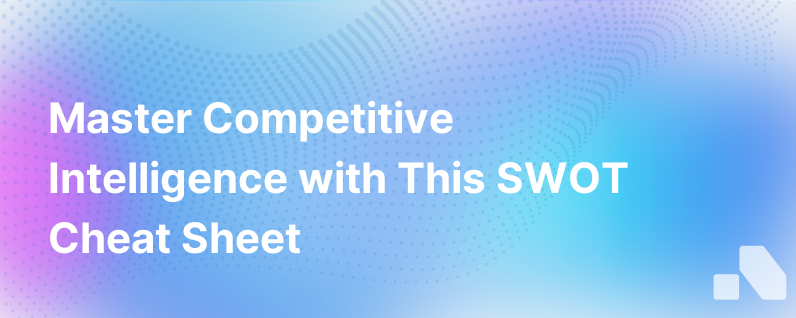Competitive Intelligence Swot Cheat Sheet
Published on November 17, 2023 by Sawyer Middeleer
In a fast-paced business landscape, competitive intelligence is non-negotiable for driving successful business decisions. Part of this process involves conducting a Competitive SWOT analysis, a tool that can be utilized to evaluate your business's Strengths, Weaknesses, Opportunities, and Threats (SWOT).
This Competitive Intelligence SWOT cheat sheet aims to provide you with a thorough guide to leveraging this tool to gain a competitive edge in your marketplace.
Competitive Intelligence - A Brief Primer
Competitive intelligence (CI) represents the process of gathering actionable competitor insights with which you can make informed strategic decisions. It involves analyzing various aspects of the competitive environment, including current market trends, competitor activities, or demographic shifts.
Armed with the right competitive intelligence, you can mitigate risks, spot opportunities, and adjust product strategies and, ultimately, gain a strategic edge over your rivals.
The Power of a Competitive SWOT Analysis
At the heart of competitive intelligence lies the SWOT analysis. The SWOT analysis is a strategic planning tool that evaluates your organization's internal strengths and weaknesses, as well as external opportunities and threats.
Performing a SWOT analysis can help your business identify how to exploit its strengths, shore up its weaknesses, seize market opportunities, and prepare for potential threats.
Components of a Competitive SWOT Analysis
-
Strengths: These are what your business excels at and what separates you from the competition. Strengths should be perceived from both internal perspectives and from the point of view of your customers and people in your market.
-
Weaknesses: These are areas where your business may lack or areas that need improvement to maintain competitiveness.
-
Opportunities: External factors, such as an unfulfilled customer need, that your company could leverage to gain a competitive advantage.
-
Threats: These are external factors that could jeopardize the success of your business.
Conducting a Competitive SWOT Analysis: The Cheat Sheet
Here’s a step-by-step guide to conducting a competitive SWOT analysis for your business.
Step 1: Research your company's strengths:
- What does your company do better than your competitors?
- What unique capabilities or resources do you possess?
- What do your customers value about your product/service?
Step 2: Identify your company's weaknesses:
- What do you lack compared to your competitors?
- What's leading customers to choose your competitors over you?
- What are some of the complaints you often receive from customers?
Step 3: Uncover opportunities in your market:
- Are there emerging trends that might give you a competitive edge?
- Are there needs not met by your competition that you can exploit?
- Are there any changes in market policies, social patterns, population profiles, lifestyle changes, or technology on which you can capitalize?
Step 4: Recognize potential threats:
- Who are your existing or potential competitors?
- Do you have solid financial support?
- What's your plan if your competitors release a new product or service?
Step 5: Develop strategies from your SWOT:
- Leverage your strengths and opportunities to your benefit.
- Improve your weaknesses and minimize your threats.
Common Mistakes While Conducting A SWOT Analysis
It’s worth noting that conducting a SWOT analysis is as much about avoiding pitfalls as it is about following best practices. Below are some common mistakes:
- Over-complication: Keep your SWOT analysis simple. It’s not about minutiae but about larger trends, threats, and opportunities.
- Ignoring competition: In focusing on your business, it’s easy to overlook that a SWOT analysis is also about understanding your competitors something AI tools like Aomni are especially good at.
- Being too optimistic or pessimistic: A SWOT analysis should be balanced. Don’t inflate strengths and opportunities because you’re feeling good, or dwell exclusively on weaknesses and threats because the going is tough.
Conducting a regular SWOT analysis is fundamental to maintaining and increasing competitive advantage, and keeping it up to date is vital. Technologies like Aomni help you automate your competitive intelligence collection, ensuring your SWOT analysis always represents the most current snapshot of your company's competitive landscape.
In conclusion, a competitive SWOT analysis is an invaluable tool for helping your business strategize and react to changes within your industry. Remember that while the SWOT analysis is a powerhouse tool, it must be regularly updated to remain relevant. We suggest quarterly updates, or even more frequently if your industry is fast-moving or changing significantly due to external factors.